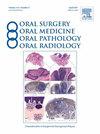Social Determinants of Health-Related Quality of Life Outcomes for Head and Neck Cancer Patients
Oral surgery, oral medicine, oral pathology, oral radiology, and endodontics
Pub Date : 2021-11-03
DOI:10.3390/oral1040031
引用次数: 4
Abstract
The influence of area-based and individual indicators of socioeconomic status (SES) on health-related quality of life (HRQOL) and patient concerns following head and neck cancer is complex and under-reported. The aim of this study is to use baseline data collected as part of a randomised controlled trial to provide greater detail on the attribution of SES to University of Washington Quality of Life version 4 (UWQOL v4), Distress Thermometer and European Quality of Life Five-Dimension Five-Level (EQ-5D-5L) outcomes. A total of 288 trial patients attended baseline clinics a median (Interquartile (IQR)) of 103 (71–162) days after the end of treatment. Area-based SES was assessed using the Index of Multiple Deprivation (IMD) 2019. Thirty-eight per cent (110/288) of patients lived in the most deprived IMD rank quintile. Less than good overall quality of life (31% overall) was associated with current working situation (p = 0.008), receipt of financial benefits (p < 0.001), total household income (p = 0.003) and use of tobacco (p = 0.001). Income and employment were significant patient level indicators predictors of HRQOL outcomes after case-mix adjustment. The number of Patient Concerns Inventory items selected varied significantly by overall clinical tumour clinical stage (p < 0.001) and by treatment (p < 0.001) but not by area IMD or patient-level deprivation indicators. In conclusion, interventions to improve employment and finance could make a substantial positive effect on HRQOL outcomes and concerns.头颈癌患者健康相关生活质量结局的社会决定因素
基于地区和个体的社会经济地位指标(SES)对头颈癌后与健康相关的生活质量(HRQOL)和患者关注的影响是复杂且报道不足的。本研究的目的是使用作为随机对照试验的一部分收集的基线数据,以提供有关SES归因于华盛顿大学生活质量4版(UWQOL v4),窘迫温度计和欧洲生活质量五维五水平(EQ-5D-5L)结果的更详细信息。共有288名试验患者在治疗结束后103(71-162)天的中位数(四分位数间隔(IQR))基线诊所就诊。基于地区的社会经济状况评估采用2019年多重剥夺指数(IMD)。38%(110/288)的患者生活在最贫困的IMD排名五分之一。总体生活质量不佳(31%)与目前的工作状况(p = 0.008)、经济福利(p < 0.001)、家庭总收入(p = 0.003)和吸烟(p = 0.001)相关。经病例组合调整后,收入和就业是HRQOL结果的显著患者水平指标预测因子。所选择的患者关注清单项目的数量因总体临床肿瘤临床分期(p < 0.001)和治疗(p < 0.001)而显着变化,但不受地区IMD或患者水平剥夺指标的影响。综上所述,改善就业和财政的干预措施可以对HRQOL的结果和关注产生实质性的积极影响。
本文章由计算机程序翻译,如有差异,请以英文原文为准。
求助全文
约1分钟内获得全文
求助全文
来源期刊
自引率
0.00%
发文量
0
审稿时长
1 months

 求助内容:
求助内容: 应助结果提醒方式:
应助结果提醒方式:


